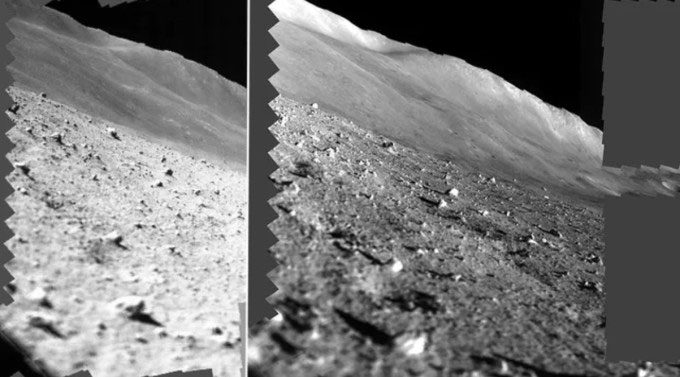The SLIM spacecraft will face a long, cold night on the Moon in a dormant state and may never wake up afterward.
Japan’s SLIM lander ran out of energy before the cold lunar night concluded its mission but managed to transmit final images and scientific data, Space reported on February 1.

SLIM lander captured during landing (left) and when it resumed operations. (Photo: JAXA).
SLIM (Smart Lander for Investigating Moon) successfully landed precisely at the rim of the Shioli crater on January 19, despite engine issues due to the spacecraft landing upside down. As a result, the solar panels of the spacecraft faced west and did not receive the expected amount of sunlight, initially causing the lander to suspend operations on the lunar surface. However, SLIM resumed operations nearly 10 days after landing, as sunlight reached its solar panels.
The Japan Aerospace Exploration Agency (JAXA), which operates SLIM, has spent the recent days scanning the nearby lunar surface with a multi-band camera (MBC) to investigate its compositional structure. The MBC is designed to detect olivine and various other minerals through spectral analysis of reflected sunlight, according to the non-profit organization Planetary Society.
JAXA shared the final image taken with SLIM’s directional camera on January 31. They also confirmed that the spacecraft has entered a dormant state as expected. JAXA will need to wait through the long lunar night, lasting approximately 14.5 Earth days, along with favorable lighting and temperature conditions during the next daytime period (starting around February 15) before SLIM can potentially be revived again. However, for the lander to wake up, its electronics must remain oriented toward the equator during the lunar night, when temperatures drop to around -130 degrees Celsius.
Regardless of whether SLIM awakens, the spacecraft has fully achieved its mission objectives, including precise landing, deploying two small rovers, and collecting a wealth of scientific data. “Based on the large amount of data collected, we are conducting analyses to identify rocks and estimate the chemical composition of minerals, contributing to solving the mystery of the Moon’s origins,” JAXA stated.




















































